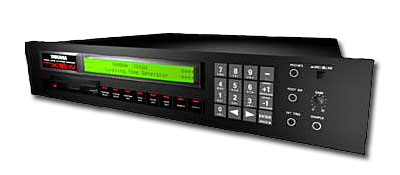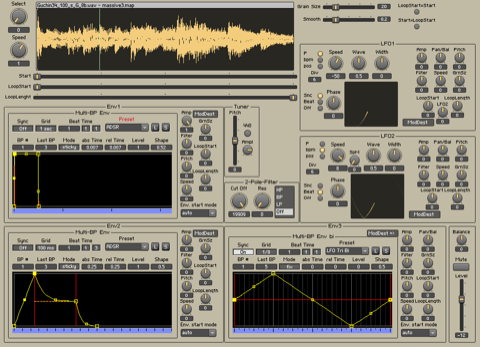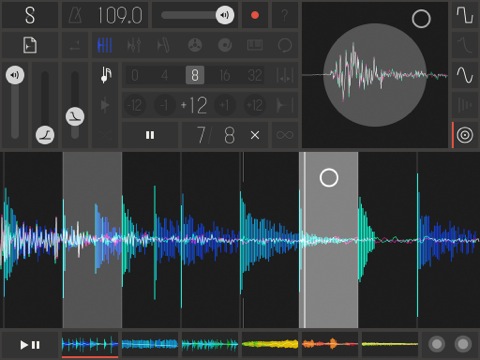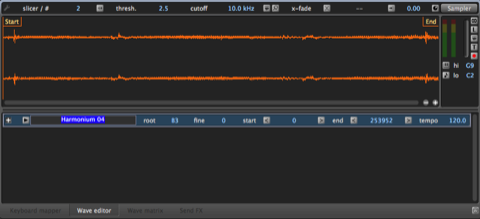TX16Wx - In Search of the Perfect Sampler
Like many electronic musicians, I started with trackers and have very fond feelings for working with samples. For a long time I tried to find the Perfect Sampler, hardware or software. but every time there was something not quite right. The requirements for the Ideal Sampler were the following: the ability to automate or modulate the starting point and loop length, convenient loading of samples, the ability to switch “on the go” samples in one directory. I want to share my observations and thoughts, as well as a small review of the software sampler TX16Wx.

')

Closest to the ideal was a tool for “Reactor” called MRS, which, unfortunately, exists only in the form of a long-abandoned beta, does not know how to save presets, besides, it resets all settings after reloading the project. The only way to work with it normally is to render everything immediately and save it to the audio track. Not being a great specialist in the “Reactor”, I could not modify it myself, and no one else became interested. Pros: excellent modulation of everything you want, very convenient (although not the most beautiful) interface. Cons: voiced above.
The process of transformation of sound in the MRS can be seen on this video .
Upd: since the tool itself has long since disappeared in the depths of the user library / test area, I perezalil it here .

A delightful instrument from the future, which has only one drawback - it only works on the iPad, respectively, you can forget about the normal integration into the DAW and the convenient loading of samples (the new versions, however, are friends with AudioBus and allow you to use it with other music applications some internal sequencer). As a separate unit - a real find for those who work in the genres of ambient, IDM and Glitch. It makes it possible to make an excellent atmospheric pad from a rather short sample, and to cut a ready-to-use excerpt into small pieces, and also to make a sticking effect. I use it actively in cases when a clear hit to the rhythm is not critical, I often skip it through the Kaoss Pad.

Very convenient free sampler with an elegant interface, support for drag'n'drop, flexible modulation, the ability to create multi-layer instruments, two filters, an LFO, a step sequencer and other necessary elements. Only the Windows version is available.

Virtual implementation of the sampler Yamaha TX16W, produced in the late 80s. The number one contender for the title of Ideal Sampler, so I’ll dwell on it in more detail. The basic version is completely free and enough for the eyes of most tasks. TX16Wx supports drag'n'drop, so you can safely drag files into it from the Finder or the conductor (besides, there is a built-in browser for downloading samples with automatic preview). Available in the form of VST and AU-plug-ins, which can be loaded in both stereo and mono mode, and in multi output mode, for example, with 16 mono outputs or 8 - stereo. In the last two cases, in one instance of the sampler it will be possible to create not one tool (program), but 16 or 8, respectively.
The sample is loaded on the Keyboard mapper tab, by default, however, the sample is loaded only on one key in fixed scale mode, so you need to stretch the appeared zone to the entire keyboard and switch it to normal scale mode - and you can play right away. For simple sound editing, there are envelope controls (with two damping points and intermediate level adjustment between them), a common sound and pan controls, and a keyboard sensitivity setting (you can reverse, i.e., with a stronger pressure, the sound will be quieter). Also available for quick setup are the starting point of wave playback, smoothness of the change in tone and playback delay. Next comes an eight-mode filter with adjustable cut-off angle and two low-frequency oscillators (LFOs), in which you can adjust the waveform, frequency, amplitude, phase, choose between continuous operation or restart during each press, and also start the oscillator smoothly using the fade knob in. The next processing block contains two traditional envelopes and three step sequencers. Everything is clear here.
All this splendor can be connected to the modulation table, consisting of 16 cells. The modulation capabilities are really impressive. The source can be LFO, envelopes, step sequencers, pressing force, aftertouch, keytrack, external controllers, as well as the excellent “random” function. Almost any parameters can be modulated: volume, pan, pitch, start of the playback point, start, end, direction and length of the loop, delay, smoothness of change of tone, etc. You can build completely insane things, up to such combinations as an oscillator that controls its own frequency.

On the Wave Editor tab, you can perform all sorts of operations with the wave itself, cut off extra pieces, reverse, convert stereo to mono, set start points, position and length of a loop, automatically determine the tempo and pitch, cut the sound into pieces and arrange them on the keys. If the loop is not made from a rhythmic segment but, for example, from strings, you can use a smooth transition to repeat (x-fade). In addition, from here you can also record an incoming signal bypassing the host itself (although it’s not possible to record, say, a segment directly from Youtube or from an mp3 file, at least without using special drivers like Soundflower.)
These are, in general, the basic functions of the TX16Wx. Paid PRO-version allows you to use six tires with effects, which, however, is absolutely not critical - it is much more convenient and economical to do in the host itself. Another, much more interesting feature of the full version - Wave Matrix - is the ability to switch between different waves based on different parameters.

')
Mrs

Closest to the ideal was a tool for “Reactor” called MRS, which, unfortunately, exists only in the form of a long-abandoned beta, does not know how to save presets, besides, it resets all settings after reloading the project. The only way to work with it normally is to render everything immediately and save it to the audio track. Not being a great specialist in the “Reactor”, I could not modify it myself, and no one else became interested. Pros: excellent modulation of everything you want, very convenient (although not the most beautiful) interface. Cons: voiced above.
The process of transformation of sound in the MRS can be seen on this video .
Upd: since the tool itself has long since disappeared in the depths of the user library / test area, I perezalil it here .
SAMPLR

A delightful instrument from the future, which has only one drawback - it only works on the iPad, respectively, you can forget about the normal integration into the DAW and the convenient loading of samples (the new versions, however, are friends with AudioBus and allow you to use it with other music applications some internal sequencer). As a separate unit - a real find for those who work in the genres of ambient, IDM and Glitch. It makes it possible to make an excellent atmospheric pad from a rather short sample, and to cut a ready-to-use excerpt into small pieces, and also to make a sticking effect. I use it actively in cases when a clear hit to the rhythm is not critical, I often skip it through the Kaoss Pad.
Short circuit

Very convenient free sampler with an elegant interface, support for drag'n'drop, flexible modulation, the ability to create multi-layer instruments, two filters, an LFO, a step sequencer and other necessary elements. Only the Windows version is available.
TX16Wx

Virtual implementation of the sampler Yamaha TX16W, produced in the late 80s. The number one contender for the title of Ideal Sampler, so I’ll dwell on it in more detail. The basic version is completely free and enough for the eyes of most tasks. TX16Wx supports drag'n'drop, so you can safely drag files into it from the Finder or the conductor (besides, there is a built-in browser for downloading samples with automatic preview). Available in the form of VST and AU-plug-ins, which can be loaded in both stereo and mono mode, and in multi output mode, for example, with 16 mono outputs or 8 - stereo. In the last two cases, in one instance of the sampler it will be possible to create not one tool (program), but 16 or 8, respectively.
The sample is loaded on the Keyboard mapper tab, by default, however, the sample is loaded only on one key in fixed scale mode, so you need to stretch the appeared zone to the entire keyboard and switch it to normal scale mode - and you can play right away. For simple sound editing, there are envelope controls (with two damping points and intermediate level adjustment between them), a common sound and pan controls, and a keyboard sensitivity setting (you can reverse, i.e., with a stronger pressure, the sound will be quieter). Also available for quick setup are the starting point of wave playback, smoothness of the change in tone and playback delay. Next comes an eight-mode filter with adjustable cut-off angle and two low-frequency oscillators (LFOs), in which you can adjust the waveform, frequency, amplitude, phase, choose between continuous operation or restart during each press, and also start the oscillator smoothly using the fade knob in. The next processing block contains two traditional envelopes and three step sequencers. Everything is clear here.
All this splendor can be connected to the modulation table, consisting of 16 cells. The modulation capabilities are really impressive. The source can be LFO, envelopes, step sequencers, pressing force, aftertouch, keytrack, external controllers, as well as the excellent “random” function. Almost any parameters can be modulated: volume, pan, pitch, start of the playback point, start, end, direction and length of the loop, delay, smoothness of change of tone, etc. You can build completely insane things, up to such combinations as an oscillator that controls its own frequency.

On the Wave Editor tab, you can perform all sorts of operations with the wave itself, cut off extra pieces, reverse, convert stereo to mono, set start points, position and length of a loop, automatically determine the tempo and pitch, cut the sound into pieces and arrange them on the keys. If the loop is not made from a rhythmic segment but, for example, from strings, you can use a smooth transition to repeat (x-fade). In addition, from here you can also record an incoming signal bypassing the host itself (although it’s not possible to record, say, a segment directly from Youtube or from an mp3 file, at least without using special drivers like Soundflower.)
These are, in general, the basic functions of the TX16Wx. Paid PRO-version allows you to use six tires with effects, which, however, is absolutely not critical - it is much more convenient and economical to do in the host itself. Another, much more interesting feature of the full version - Wave Matrix - is the ability to switch between different waves based on different parameters.
Source: https://habr.com/ru/post/191134/
All Articles